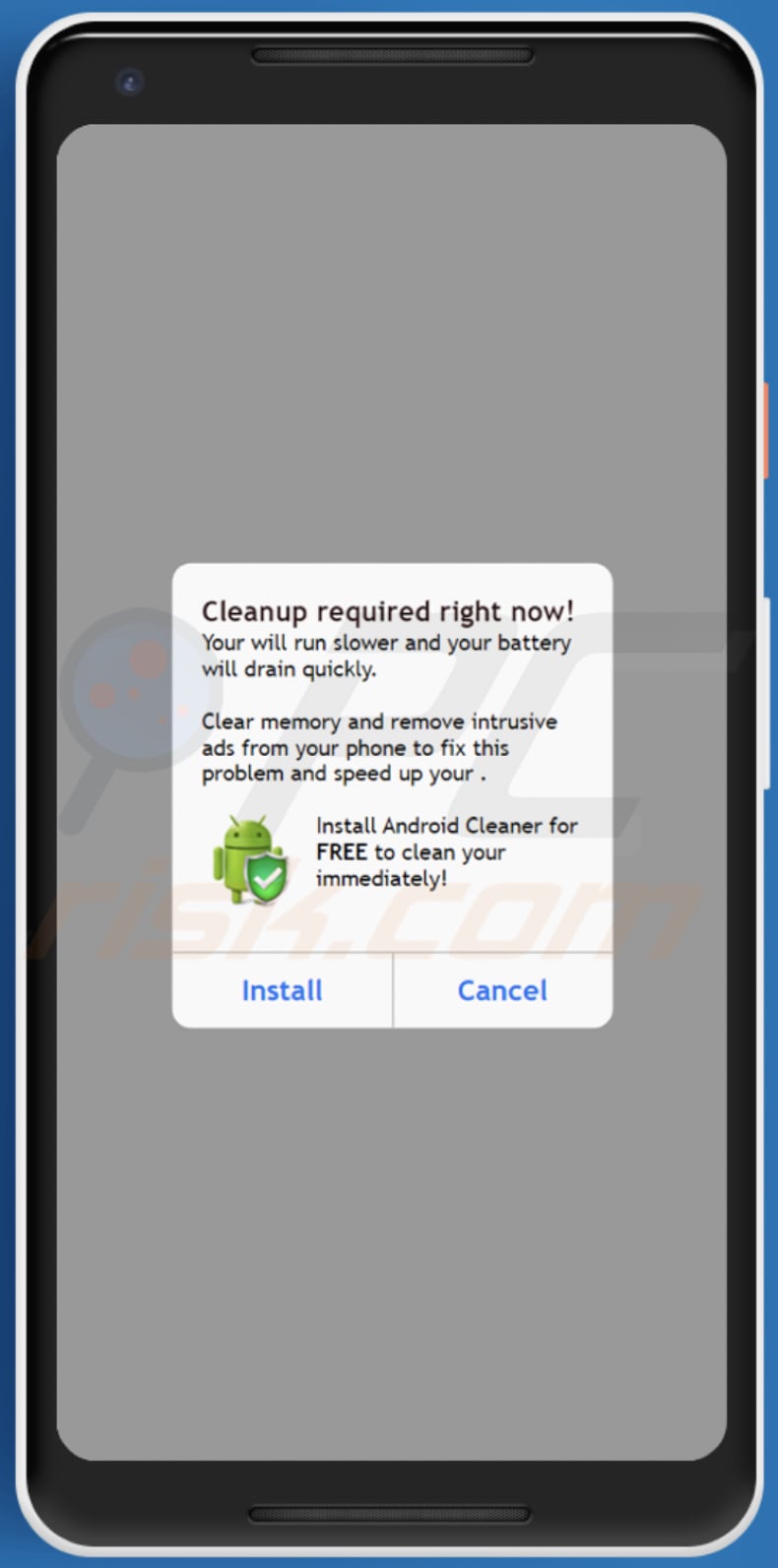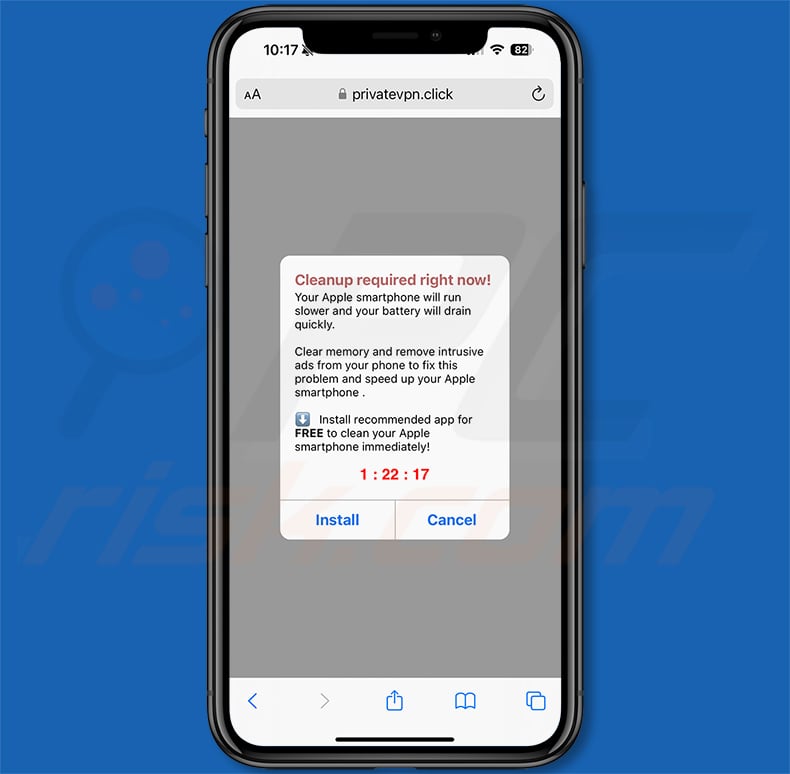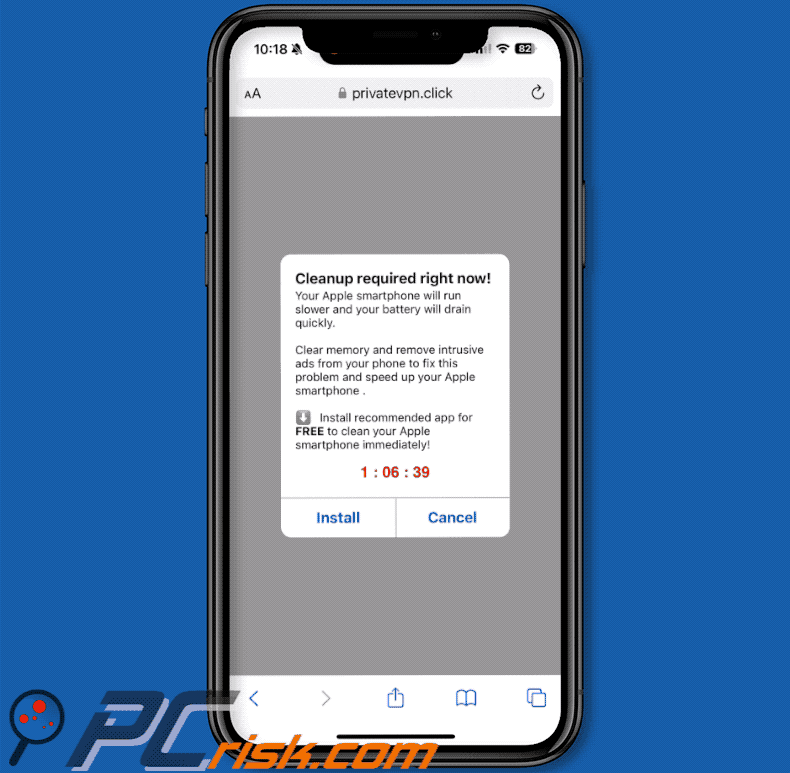Do not trust the Cleanup required right now! message on a deceptive page
Phishing/ScamAlso Known As: Cleanup required right now! pop-up
Get free scan and check if your device is infected.
Remove it nowTo use full-featured product, you have to purchase a license for Combo Cleaner. Seven days free trial available. Combo Cleaner is owned and operated by RCS LT, the parent company of PCRisk.com.
What is the Cleanup required right now! scam?
The "Cleanup required right now!" fake notification appears on a deceptive website designed to trick Android users into installing an unwanted application that is supposed to speed up a device. Typically, websites of this kind are promoted through other shady websites, deceptive ads, and dubious applications.

Cleanup required right now! scam in detail
The main purpose of this deceptive website is to trick visitors into thinking that their device will run slower and the battery will drain more quickly if users do not install and use the offered app. That app is supposed to speed up a device by clearing its memory and blocking unwanted advertisements.
It is unknown what is the true purpose of the application that is promoted on this website. However, it might be designed to function as adware (advertising-supported software). More precisely, that app might be designed to generate unwanted advertisements (for example, pop-ups, banners, coupons, surveys).
Pretty often, advertisements displayed by adware promote questionable websites, for example, download pages for other potentially unwanted applications, shady websites asking to provide personal information (credit card details, usernames, email addresses, passwords, and so on). Sometimes, those ads can run certain scripts and download or install unwanted software.
Also, this deceptive website may be used to promote a browser hijacker - an unwanted program designed to alter browser's settings such as the address of a default search engine, homepage, and new tab. Usually, browser hijackers promote fake search engines designed to show results generated by legitimate and (or) untrustworthy search engines.
It is also possible that the app promoted through this page is designed to collect entered search queries, visited websites, IP addresses, and other browsing-related data. Moreover, it may be designed to collect sensitive information (credit card details, login credentials) that could be misused to hijack accounts, steal identities, or in monetized in other ways.
| Name | Cleanup required right now! pop-up |
| Threat Type | Android malware, malicious application, unwanted application. |
| Related Domain | cosmodjan[.]com, battery-alert[.]com |
| Detection Names (battery-alert[.]com) | Fortinet (Malware), Full List (VirusTotal) |
| Serving IP Address | 172.67.71.94 |
| Symptoms | The device is running slow, system settings are modified without user's permission, questionable applications appear, data and battery usage is increased significantly, browsers redirect to questionable websites, intrusive advertisements are delivered. |
| Distribution methods | Infected email attachments, malicious online advertisements, social engineering, deceptive applications, scam websites. |
| Damage | Stolen personal information (private messages, logins/passwords, etc.), decreased device performance, battery is drained quickly, decreased Internet speed, huge data losses, monetary losses, stolen identity (malicious apps might abuse communication apps). |
| Malware Removal (Windows) |
To eliminate possible malware infections, scan your computer with legitimate antivirus software. Our security researchers recommend using Combo Cleaner. Download Combo CleanerTo use full-featured product, you have to purchase a license for Combo Cleaner. 7 days free trial available. Combo Cleaner is owned and operated by RCS LT, the parent company of PCRisk.com. |
Similar scams in general
Lots of websites use scare tactics to trick visitors into downloading and installing unwanted programs or even malicious applications. Usually, they display fake notifications claiming that there is some problem with a device. A couple of examples of other similar pages are "Your Chrome Device May Be Too Old" and "Your Android Is Infected With (8) Adware Viruses!".
As mentioned in the first paragraph, it is common for deceptive websites to be promoted through rogue apps. Therefore, if a browser (or device) opens those pages by itself, it possibly has a shady app installed on it. It is strongly recommended to uninstall any installed unwanted apps as soon as possible.
How most unwanted applications are distributed?
Typically, users download or install rogue apps through downloaders or installers for free programs (when they do not deselect optional offers before completing downloads or installations of those programs). Additionally included applications can be deselected via "Custom", "Advanced", "Manual", or other settings, or by unticking checkboxes.
In other cases, users cause unexpected downloads or installations by clicking advertisements designed to run certain scripts or through fake installers. Fake installers can be designed to install malicious applications. Typically, fake installers are promoted through deceptive pages.
How to avoid installation of unwanted applications?
It is recommended to use legitimate sources to download files or programs, for example, official websites and direct download links. Peer-to-Peer networks (torrent clients, eMule, and other similar networks), third-party downloaders and installers, unofficial websites, and so on can be used to distribute unwanted and even malicious software.
Furthermore, it is advisable not to complete downloads or installations without checking downloaders, installers for settings like "Custom", "Advanced", and declining unwanted offers. One more way to avoid unwanted downloads, installations is not to click on ads that appear on pages related to gambling, adult dating, and other questionable sites.
Unwanted, suspicious programs installed on the operating system should be uninstalled. The same should be applied to extensions, add-ons, or plug-ins of this kind installed on a browser.
Screenshot of an identical scam targeting iPhone users:

Text presented within:
Cleanup required right now!
Your Apple smartphone will run slower and your battery will drain quickly.
Clear memory and remove intrusive ads from your phone to fix this problem and speed up your Apple smartphone .
Install recommended app for FREE to clean your Apple smartphone immediately!
Appearance of this scam (GIF):

Quick menu:
- Introduction
- How to delete browsing history from the Chrome web browser?
- How to disable browser notifications in the Chrome web browser?
- How to reset the Chrome web browser?
- How to delete browsing history from the Firefox web browser?
- How to disable browser notifications in the Firefox web browser?
- How to reset the Firefox web browser?
- How to uninstall potentially unwanted and/or malicious applications?
- How to boot the Android device in "Safe Mode"?
- How to check the battery usage of various applications?
- How to check the data usage of various applications?
- How to install the latest software updates?
- How to reset the system to its default state?
- How to disable applications that have administrator privileges?
Delete browsing history from the Chrome web browser:

Tap the "Menu" button (three dots on the right-upper corner of the screen) and select "History" in the opened dropdown menu.

Tap "Clear browsing data", select "ADVANCED" tab, choose the time range and data types you want to delete and tap "Clear data".
Disable browser notifications in the Chrome web browser:

Tap the "Menu" button (three dots on the right-upper corner of the screen) and select "Settings" in the opened dropdown menu.

Scroll down until you see "Site settings" option and tap it. Scroll down until you see "Notifications" option and tap it.

Find the websites that deliver browser notifications, tap on them and click "Clear & reset". This will remove permissions granted for these websites to deliver notifications. However, once you visit the same site again, it may ask for a permission again. You can choose whether to give these permissions or not (if you choose to decline the website will go to "Blocked" section and will no longer ask you for the permission).
Reset the Chrome web browser:

Go to "Settings", scroll down until you see "Apps" and tap it.

Scroll down until you find "Chrome" application, select it and tap "Storage" option.

Tap "MANAGE STORAGE", then "CLEAR ALL DATA" and confirm the action by taping "OK". Note that resetting the browser will eliminate all data stored within. This means that all saved logins/passwords, browsing history, non-default settings and other data will be deleted. You will also have to re-login into all websites as well.
Delete browsing history from the Firefox web browser:

Tap the "Menu" button (three dots on the right-upper corner of the screen) and select "History" in the opened dropdown menu.

Scroll down until you see "Clear private data" and tap it. Select data types you want to remove and tap "CLEAR DATA".
Disable browser notifications in the Firefox web browser:

Visit the website that is delivering browser notifications, tap the icon displayed on the left of URL bar (the icon will not necessarily be a "Lock") and select "Edit Site Settings".

In the opened pop-up opt-in the "Notifications" option and tap "CLEAR".
Reset the Firefox web browser:

Go to "Settings", scroll down until you see "Apps" and tap it.

Scroll down until you find "Firefox" application, select it and tap "Storage" option.

Tap "CLEAR DATA" and confirm the action by taping "DELETE". Note that resetting the browser will eliminate all data stored within. This means that all saved logins/passwords, browsing history, non-default settings and other data will be deleted. You will also have to re-login into all websites as well.
Uninstall potentially unwanted and/or malicious applications:

Go to "Settings", scroll down until you see "Apps" and tap it.

Scroll down until you see a potentially unwanted and/or malicious application, select it and tap "Uninstall". If, for some reason, you are unable to remove the selected app (e.g., you are prompted with an error message), you should try using the "Safe Mode".
Boot the Android device in "Safe Mode":
The "Safe Mode" in Android operating system temporarily disables all third-party applications from running. Using this mode is a good way to diagnose and solve various issues (e.g., remove malicious applications that prevent users you from doing so when the device is running "normally").

Push the "Power" button and hold it until you see the "Power off" screen. Tap the "Power off" icon and hold it. After a few seconds the "Safe Mode" option will appear and you'll be able run it by restarting the device.
Check the battery usage of various applications:

Go to "Settings", scroll down until you see "Device maintenance" and tap it.

Tap "Battery" and check the usage of each application. Legitimate/genuine applications are designed to use as low energy as possible in order to provide the best user experience and to save power. Therefore, high battery usage may indicate that the application is malicious.
Check the data usage of various applications:

Go to "Settings", scroll down until you see "Connections" and tap it.

Scroll down until you see "Data usage" and select this option. As with battery, legitimate/genuine applications are designed to minimize data usage as much as possible. This means that huge data usage may indicate presence of malicious application. Note that some malicious applications might be designed to operate when the device is connected to wireless network only. For this reason, you should check both Mobile and Wi-Fi data usage.

If you find an application that uses a lot of data even though you never use it, then we strongly advise you to uninstall it as soon as possible.
Install the latest software updates:
Keeping the software up-to-date is a good practice when it comes to device safety. The device manufacturers are continually releasing various security patches and Android updates in order to fix errors and bugs that can be abused by cyber criminals. An outdated system is way more vulnerable, which is why you should always be sure that your device's software is up-to-date.

Go to "Settings", scroll down until you see "Software update" and tap it.

Tap "Download updates manually" and check if there are any updates available. If so, install them immediately. We also recommend to enable the "Download updates automatically" option - it will enable the system to notify you once an update is released and/or install it automatically.
Reset the system to its default state:
Performing a "Factory Reset" is a good way to remove all unwanted applications, restore system's settings to default and clean the device in general. However, you must keep in mind that all data within the device will be deleted, including photos, video/audio files, phone numbers (stored within the device, not the SIM card), SMS messages, and so forth. In other words, the device will be restored to its primal state.
You can also restore the basic system settings and/or simply network settings as well.

Go to "Settings", scroll down until you see "About phone" and tap it.

Scroll down until you see "Reset" and tap it. Now choose the action you want to perform:
"Reset settings" - restore all system settings to default;
"Reset network settings" - restore all network-related settings to default;
"Factory data reset" - reset the entire system and completely delete all stored data;
Disable applications that have administrator privileges:
If a malicious application gets administrator-level privileges it can seriously damage the system. To keep the device as safe as possible you should always check what apps have such privileges and disable the ones that shouldn't.

Go to "Settings", scroll down until you see "Lock screen and security" and tap it.

Scroll down until you see "Other security settings", tap it and then tap "Device admin apps".

Identify applications that should not have administrator privileges, tap them and then tap "DEACTIVATE".
Frequently Asked Questions (FAQ)
What is a pop-up scam?
A pop-up scam usually involves fake messages (e.g., fake system warnings) designed to trick unsuspecting users into performing certain actions.
What is the purpose of a pop-up scam?
In most cases, these scams are designed to trick users into downloading malware or other unwanted software, providing personal information (e.g., credit card details or passwords), or paying for unnecessary services.
Why do I encounter fake pop-ups?
These pop-ups usually are encountered on deceptive pages or through misleading ads, notifications from dubious pages, fraudulent emails (or messages) containing links, or shady applications installed on devices. Torrent sites and other pages that use rogue advertising networks can also lead to pop-up scams.
Will Combo Cleaner protect me from pop-up scams?
Combo Cleaner is designed to scan every single website you visit and it is capable of detecting the malicious ones. Sites designed to deliver pop-up scams also fall under this category, thus, you will be warned immediately and the access will be restricted.
Share:

Tomas Meskauskas
Expert security researcher, professional malware analyst
I am passionate about computer security and technology. I have an experience of over 10 years working in various companies related to computer technical issue solving and Internet security. I have been working as an author and editor for pcrisk.com since 2010. Follow me on Twitter and LinkedIn to stay informed about the latest online security threats.
PCrisk security portal is brought by a company RCS LT.
Joined forces of security researchers help educate computer users about the latest online security threats. More information about the company RCS LT.
Our malware removal guides are free. However, if you want to support us you can send us a donation.
DonatePCrisk security portal is brought by a company RCS LT.
Joined forces of security researchers help educate computer users about the latest online security threats. More information about the company RCS LT.
Our malware removal guides are free. However, if you want to support us you can send us a donation.
Donate
▼ Show Discussion